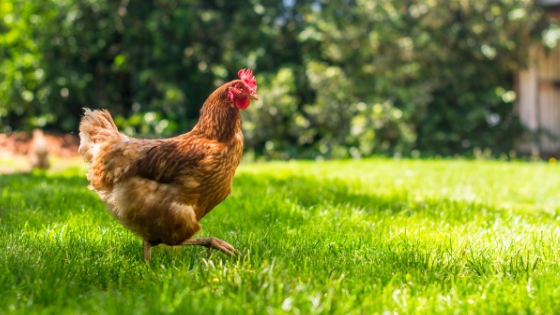Most families that keep a flock of backyard chickens have a front or side lawn, but few use it to advantage. Even a small lawn can help chickens. There are many ways you can reuse your lawn clippings when you have chickens, making the passes with the mower that much more valuable!
Some lucky families let their hens roam around the yard to forage for tasty insects and plants. Often communities that allow backyard flocks prohibit free ranging birds. The birds must be confined in a coop or enclosed run. Even if there is no law barring free ranging, it comes with problems. Chickens on the loose are vulnerable to neighborhood dogs and wild predators. They also have the irritating habit of scratching away mulch placed to protect shrubs and trees. Chickens quickly devour lettuce, spinach, chard and even tomatoes when they discover the garden.
A solution is to bring the lawn to the chickens. Simple management creates both a beautiful lush lawn and helps feed the flock.
Two important steps in creating a chicken-healthy lawn are mowing carefully and avoiding pesticides. Nature loves diversity. An un-sprayed lawn encourages many species of plants to thrive. Chickens may shun some yet devour others. Plant diversity is the welcome mat for insects, worms, and many other tiny protein-rich animals that hens covet and convert to eggs. The blend of plant diversity and an abundance of tiny animals helps feed chickens while building the healthy soil that enables a diverse lawn to thrive.
Bringing the Lawn to the Chickens
An easy way to pasture chickens is simply to bring grass to their run. Nearly all modern mowers have a bagging attachment to catch clippings. Normally the best way to care for a lawn is to avoid the bagger and let clippings decompose to add nutrients to the soil. Homeowners can follow the farm model used for centuries. Classic farmers regularly cut hay from pastures, fed it to their animals, and returned nutrients to the soil through manure. It can work the same way with a lawn. Leave most clippings on the lawn but harvest some for the hens.

To bring the lawn to the chickens simply dump a bag of fresh green lawn clippings in the run and stand back. The hens will scamper to the pile, scratch it apart, and feast on clippings and tasty insects they discover mixed in. A pile of grass clippings gives hens a fun activity and free, nutritious food.
A couple of times a year remove manure and litter from the coop, compost it for several months, and spread a thin layer on the lawn to replenish its nutrients. Compost stimulates grass to grow with as much enthusiasm as the chickens showed eating clippings.
Fresh grass fed to chickens results in deeply colored egg yolks that most people enjoy, but don’t overdo it. Keep plenty of fresh water and commercial mash available to chickens so they can maintain a balanced diet.
Lawn Hay
Dry, sweet smelling grass hay makes a perfect nest lining. It is easy to make from lawn clippings. Simply let the lawn grow taller than usual. Six inches is a good height.
On a dry breezy day remove the bagger from the mower, allowing the machine to spit out bunches of moist green grass. Use a leaf rake to form rows of clippings fluffed up so air can circulate between the grass blades. Sun and a light breeze will cure the hay in a few hours. Once it is thoroughly dry, rake the hay up and store it in a tight-fitting metal garbage can. It will keep for months. Every once in a while, remove old soiled clippings from nests and add them to the compost pile. Put an inch or two of new dry clean lawn hay in the nest, and it will cushion eggs and add a slight pleasant grassy fragrance to the coop.
Consider a Battery Powered Mower
Relatively new cordless electric mowers are quiet, lightweight, and powerful. They’ll run for upwards of an hour on a single charge and are easier to operate than a gas model. Just for example there’s no starter rope to pull. Simply push a button and start mowing.
A lawn isn’t just a place that needs to be fertilized and mowed. It’s a reusable and sustainable resource. Simple management can convert clippings into tasty chicken treats and cushioning nest linings.